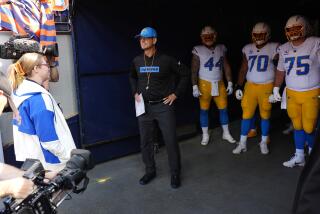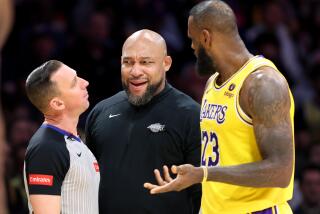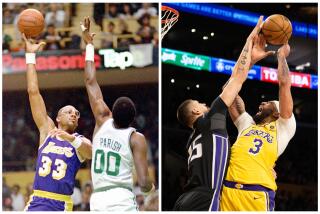After Years of Pain, Kareem Seemingly Beats Headaches : Migraines Are Given the Hook
If you watch Kareem Abdul-Jabbar closely in the National Basketball Assn. playoffs, there doesn’t seem to be much wrong with his game. The sky hook still drops, his passing is considered to be better than ever, and he hasn’t lost his ability to block shots.
But something is missing this season, and Abdul-Jabbar is glad. He hasn’t had one of those sickening migraine headaches that have struck him on and off for the last 24 years.
In last season’s championship series against Boston, Abdul-Jabbar had six migraine attacks in nine days. Even though he played through them, he was never quite sure when the migraines would return, or how severe they would be.
“Sometimes they’re not real bad, but last spring they were the worst I’ve ever had,” said Abdul-Jabbar.
He hasn’t had any since then, but as the Lakers get ready to begin the Western Conference championship series, the stress that many believe causes migraines continues to build.
That being the case, can the headaches be far behind?
There is no consensus on the subject, but one thing is certain. The issue of Abdul-Jabbar and his migraine headaches, which so far has been no issue at all, could determine whether the Lakers win a championship this season.
The pain associated with migraines is not easily described by the person who gets them.
A migraine is frequently described as “a toothache in the head,” but that really is too mild a term.
Think instead of the worst type of throbbing, numbing pain in your head, a pain so severe that you’re nauseated and can’t walk. Now imagine something worse.
“What makes it so difficult is that people think you are just having a regular headache,” Abdul-Jabbar said. “You just can’t explain them to someone who doesn’t have them.”
When he was playing with the Milwaukee Bucks, Abdul-Jabbar experienced a series of particularly bad migraines that no one seemed to know how to handle.
Laker Coach Pat Riley said that Abdul-Jabbar is the only one who knows whether he is ready to play a game if he is affected by a migraine, so Riley leaves that decision to Abdul-Jabbar.
Before Game 1 of last season’s championship series, Abdul-Jabbar experienced a migraine. He missed the team breakfast and a team meeting, but he still played and led the Lakers to a victory.
Then before Game 6, there was a question of whether Abdul-Jabbar would play because of another migraine attack. Only when Abdul-Jabbar put on his uniform at the last minute was Riley sure.
“I think if he can just get into a dark, quiet room before a game, he’s better,” Riley said. “But I can’t even relate to what he goes through.”
Larry Costello, Abdul-Jabbar’s coach with the Bucks, thought that Abdul-Jabbar would feel better if he came to Costello’s room and watched videotapes of games, Abdul-Jabbar said.
“I did it once,” the center said. “Then when I did it another time, I threw up in his room. That ended that treatment.”
Not until years later, however, did Abdul-Jabbar, who had his first attack when he was 14, get the type of treatment that seems to have brought his migraines under control.
E. David Bressler, an acupuncturist in West Los Angeles, accepted Abdul-Jabbar as a patient three seasons ago. The author of a book titled “Free Yourself From Pain,” Bressler was formerly director of the Pain Control Unit at UCLA, where he was a member of the medical school faculty before going into private practice.
Bressler was eventually able to locate the causes of Abdul-Jabbar’s migraines and then determine how to treat them. In Abdul-Jabbar’s case, Bressler said, the headaches stem from a combination of a mild allergy, muscle tension and trauma.
“Basically, it has to do with the issue of stress,” he said.
According to Bressler, stress begins a series of chain reactions that result in a migraine headache. He said that the body has a stress-response system to protect against various types of stress producers.
Bressler also said, however, that there is a limit to what that stress-response system can do. It can fight one or two enemies at a time very well, but when it’s overwhelmed, something’s got to give, he said.
“The great majority of what have been called migraine headaches are in fact mixed headaches, if they are properly diagnosed,” Bressler said. “When they come together, they can produce a real killer attack.”
As a result of stress, a great deal of muscle tension develops in the neck, Bressler said. This kind of muscle tension could be related to the clenching of teeth, or the bracing of the neck or shoulders, he said.
“Those muscles go into spasms and mechanically push against blood vessels that nourish the adjacent muscles, so the spasms spread throughout the neck and shoulder area,” Bressler said. “When it gets down into the deep muscles in the neck, it can actually compromise circulation to the brain.”
When the blood circulation is influenced, the brain thinks it’s an emergency, so it releases some chemicals, including histamine, which cause the blood vessels to open, Bressler said.
“Unfortunately, it doesn’t do anything because the blood supply is being compromised down in the neck by muscle tension,” he said.
So, as more histamine is released, the migraine victim ends up with a pounding, migraine-type headache because of constriction of the blood vessels, he said.
Bressler said migraines are often difficult to diagnose because sometimes people can eat certain foods, which they may be allergic to, and get away with it because they are not under stress.
“And other times, they are convinced that this particular food (leads to headaches) or the Santa Ana winds come and blow a couple tons of ragweed pollen into the (Los Angeles) basin and they get headaches,” Bressler said. “It’s . . . a cumulative effect of a lot of these different factors.”
After testing, Bressler discovered that Abdul-Jabbar had a mild allergy to monosodium glutamate, a salt present in the Chinese food that Abdul-Jabbar often ate.
Bressler took Abdul-Jabbar off Chinese food, treated him with acupuncture, suggested that he keep a tank of oxygen at his house as well as at games and also taught him ways to combat stress.
“We showed him how to relax those muscles in his neck and how to exert a really powerful degree of self control over his body,” Bressler said. “He was actually quite excellent at it.”
Bressler said the treatments he favors have led to a 90% rate of success for his patients. So far, Abdul-Jabbar is in the majority of Bressler’s patients.
Abdul-Jabbar said that although his job has a certain degree of stress related to it, that was not what really caused his migraine attacks last season.
He said his pursuit of Wilt Chamberlain’s scoring record was somewhat stressful, but he also blamed off-court factors, such as his breakup with girlfriend Cheryl Pistano, the publication of his autobiography “Giant Steps” and moving into a condominium while his new house was being built.
“Nothing basketball-related has really brought them on, it’s just other situations that have popped up,” he said.
Now those situations seem to be under control. Bressler said he has not treated Abdul-Jabbar since last spring and has talked to him on the phone only once during the season.
That does not mean, however, that Abdul-Jabbar is cured.
“They can recur,” Bressler said. “But to me, it’s very much like diabetes. We can’t cure diabetes. But we can treat it to the point where people can lead basically normal lives.
“The traveling, the physical demands of the game, the political demands and just the social ramifications of being a player, this is a pretty stressful type of existence,” he said.
Abdul-Jabbar said he realizes that because he cannot fully eliminate stress from his life, he may never be able to eliminate the possibility that he will have more migraines.
“That’s not realistic anyway,” he said. “You can’t eliminate stress, but what I’ve finally been able to do is learn how to manage it.”
More to Read
All things Lakers, all the time.
Get all the Lakers news you need in Dan Woike's weekly newsletter.
You may occasionally receive promotional content from the Los Angeles Times.







